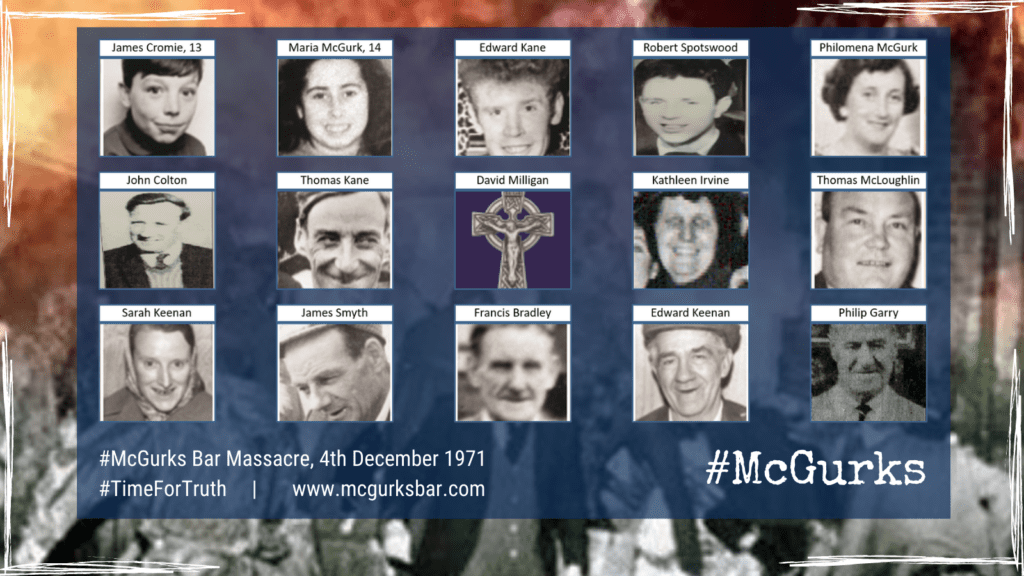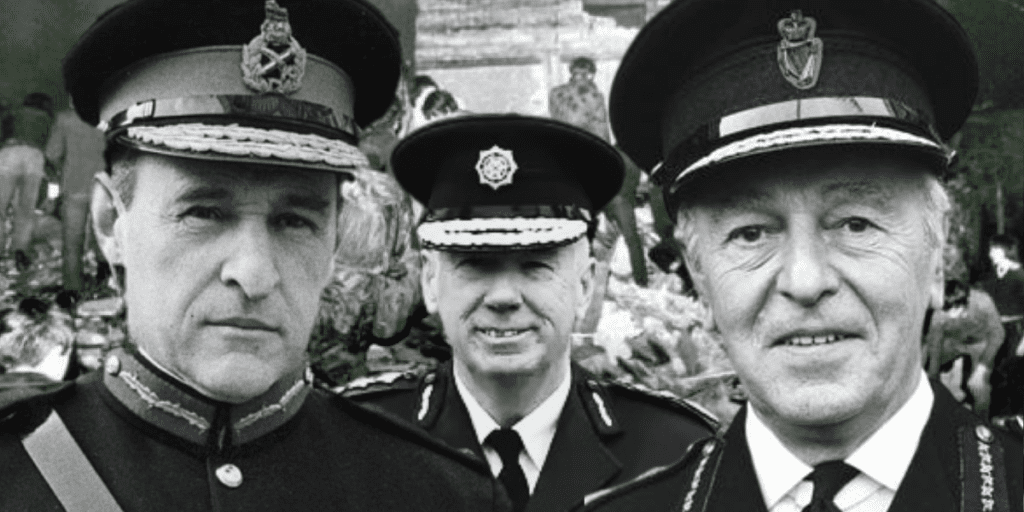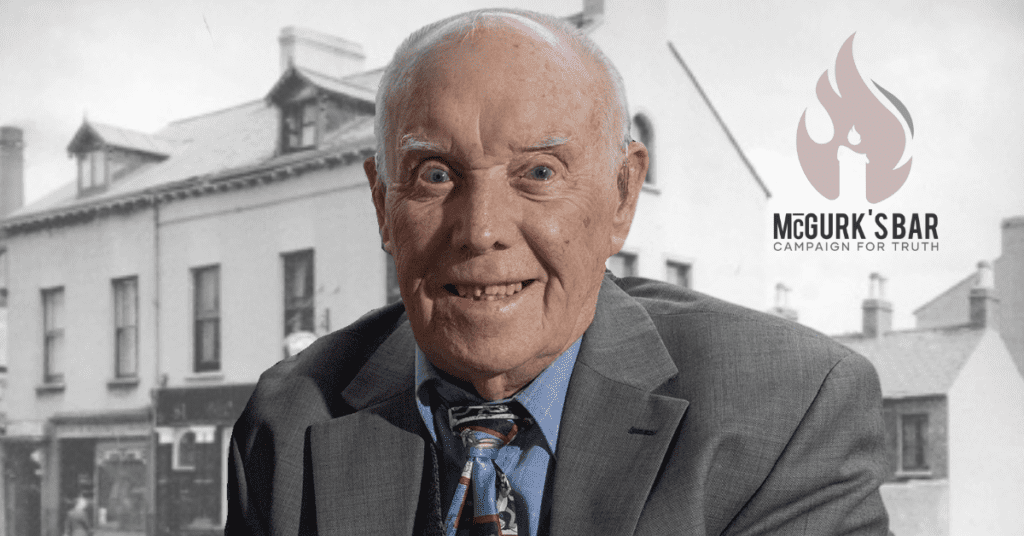What did the head of the British Army in the north, Harry Tuzo, know about the McGurk’s Bar Massacre?
Lieutenant General Sir Harry Tuzo was General Officer Commanding (GOC) the British Army at the time of the atrocity, having begun his distinguished military career before World War 2. This is what we know he knew – from the archives anyway – although this was not what he told the press.
The GOC’s Christmas message to the public was delivered at a press conference on 20th December 1971, 16 days after the McGurk’s Bar bomb claimed the lives of 15 civilians, including 2 children. Another 16 civilians were injured. At the time, it was the greatest loss of civilian life in any single murderous attack since the Nazi Blitz of Belfast.
Pro-state British extremists bombed the pub and the British state covered it up.
During the course of the press conference, Tuzo was asked about the McGurk’s Bar explosion.
The Evening Herald reported that night:
He said that from the forensic evidence they were 98 per cent certain that the bomb went off inside the building.
The Evening Herald then quoted Tuzo directly:
“It certainly rules out that anybody not known to the denizens of that pub could have got in with a parcel under his arm.”
Such evidence as the army had did not indicate Protestant action, but the army were prepared to do its job against anyone causing violence.
“My job is to supress violence wherever it comes from,” he said. “We would not wish to fight on two front [sic] but we are ready to do so if necessary.”
Vincent Browne wrote in the Irish Press (21.12.2021) explained what Tuzo meant by the army being 98% certain that the bomb was placed inside the building by somebody known to the denizens:
“…that one or other section of the IRA was responsible wither advertently or inadvertently for the catastrophe.”
The Belfast Telegraph (20.12.1971) simplified Tuzo’s words too:
“… the General said that he did not believe that anybody not known to the people in the building could have got in with a parcel under his arm. And he was 98 pc [%] certain that the bomb had gone off in the building.”
The Evening Herald also quoted his “plea” to the Irish Catholic community which reads more like a threat:
“Without the gunmen in your midst, you have nothing to fear from the Army; furthermore, we are here to protect you from any threats to your security.”
Tuzo then alleged that the “deep interrogation techniques” outlined in the Compton Report had stopped before the publication of the report. He alleged that the technique was one to which:
“a lot of other people, especially young officers, are subjected to improve their power to resist what might happen to them if they were captured.”
Vincent Browne recorded these responses to Tuzo’s Christmas message in the Irish Press:
“Mr. Michael Canavan, chairman of Derry Citizens Central Council… said last night that General Tuzo had called upon the Catholic population to help end violence, thereby implying that their intransigence was solely to blame for the disturbances.
In reality, violence was endemic in Northern Ireland because of the permanent instability of a state created and governed by sectarianism and fostering hatred as government policy, said Mr. Canavan.
Mr. Eddie McAteer, President of the Nationalist Party, said “as one member of the Catholic community here, I am not rushing under General Tuzo’s mistletoe.”
“I have personal evidence of the feelings of British troops towards Catholics and daily I see the only direction in which the guns are aimed. If this is protection, then God protect us from our protectors.”
Tuzo’s British troops and the RUC had interned hundreds of Irish Catholics without trial by then and many were brutalized. Indeed, the Hooded Men fight to this day for proper acknowledgement of their torture.
The British Army had already murdered dozens of unarmed Irish Catholic civilians by then too, including the 11 victims of the Ballymurphy Massacre in August 1971. A few weeks later, the British Army murdered 14 Irish Catholics on the streets of Derry during the Bloody Sunday Massacre.
But back to Tuzo and the McGurk’s Bar Massacre…
Tuzo and Police Lies
Just four days prior to this cheery Christmas message and press conference, Tuzo attended a Joint Security Committee Meeting at Stormont which included the Northern Ireland Prime Minister, Brian Faulkner, and his Minister of State in the Ministry of Home Affairs, John Taylor – now Lord Kilcooney – who has upset the families on numerous occasions with his false allegations about the explosion.
Also present with the General Officer Commanding was Chief Constable Graham Shillington of the Royal Ulster Constabulary; and Assistant Chief Constable David Johnston, Head of Special Branch.
As you can tell, this was a high-level meeting with men in charge of the sectarian state at the time.
Incidentally, the Security Liaison Officer there too was a member of Britain’s Security Service, MI5.

Serial 5 of the Special Branch Assessment of Agenda 1 regarded the McGurk’s Bar Massacre:
“Circumstantial evidence indicates that this was a premature detonation and two of those killed were known IRA members at least one of whom had been associated with bombing activities. Intelligence indicates that the bomb was destined for use elsewhere in the city.”

We know, of course, this was a lie.
I discovered reference to this high-level meeting in Public Records Office Northern Ireland (PRONI) nearly a decade ago and it featured in the Police Ombudsman’s report of 2011 as proof that the police briefed the Northern Ireland Prime Minister and the General Officer Commanding. The police briefed them with unadulterated lies.
Police Chiefs Lied to Tuzo
So – on its own – this could prove that the Chief Constable and head of Special Branch lied Lt. General Sir Harry Tuzo and that may explain why he misinformed the press and media about the McGurk’s Bar Massacre.
On the 49th anniversary, I challenged Chief Constable Simon Byrne to prove that two of the victims were members of the Irish Republican Army and the RUC had credible intelligence that it was an IRA bomb for another target. He has not responded to me or the families.
In fact, Police Service Northern Ireland and the Office of the Police Ombudsman have each failed to prove or tell me the provenance of these lies.
I tracked them back to within around 4 hours of the explosion. I discovered that the ‘line’ that the McGurk’s Bar Massacre was a result of an IRA ‘own-goal’, had its origins in a secret agreement between Brigadier Frank Kitson and the RUC hours after the attack.
Brigadier Frank Kitson informed British Army 39 Brigade at 0100 hours, 5th December 1971:
“RUC have a line that the bomb in the pub was a bomb designed to be used elsewhere, left in the pub to be picked up by the Provisional IRA. Bomb went off and was a mistake. RUC press office have a line on it – NI should deal with them.”

Read More: General Sir Frank Kitson Implicated in McGurk’s Bar Cover-Up
Did Brigadier Kitson misinform his boss too?
Later that morning at 0800, the RUC recorded in a Duty Officer’s Brief discovered by researcher Caroline Parkes:
“a man entered the licenced premises and left down a suitcase presumably to be picked up by a known member of the Provisional IRA. The bomb was intended for use on other premises. Before the ‘pick-up’ was made the bomb exploded.”
So, again in isolation, it may appear that the disinformation – the outworking of a secret agreement between Brigadier Frank Kitson and RUC – could have misinformed the briefing that Tuzo gave in his Christmas message to the press on 20th December 1971.
Nevertheless, we know, of course, that Tuzo and Headquarters Northern Ireland knew full well within hours that the bomb had been placed outside the pub and that McGurk’s Bar was attacked.
Director of Operations Brief
Following a targeted request for information, in 2009 I recovered critical evidence that the General Office Commanding, Lt. General Sir Harry Tuzo had been informed directly that the bomb had been placed “outside” the bar.
A Director of Operations Brief to Tuzo was prepared a few hours after the atrocity and includes the expert opinion of an Army Technical Officer. It states starkly:
“A bomb believed to have been planted outside the bar was estimated by the A.T.O. to be 30/50lb of HE (high explosive)”.
Incidentally, the time of this Director of Operations Brief is 0800 hours, the same time as the RUC Duty Officer’s Brief and its lies above.
Read the Director of Operations Brief here.
Bomb Disposal Expert Opinion
In 2016 and with the support of our legal team, I fought an Information Tribunal against the British Ministry of Defence, the National Archives and Information Commissioner’s Office for sight of a Headquarters Northern Ireland log for December 1971 which the state had closed for 84 years.
This led to disturbing proof that an ATO had investigated the bomb site in better light that morning and then informed Tuzo’s Headquarters at 1110 hours, 5th December 1971:
“ATO [Ammunition Technical Officer] is convinced bomb was placed in entrance way on ground floor. The area is cratered and clearly was the seat of the explosion.”

All of the historic investigations informed our families that the seat of the explosion was never discovered but it had been and it was in exactly the place where the paper boy witness said that the bombers left it.
The ATO’s report had first gone to Kitson’s Brigade Headquarters:
“As far as can be assessed from the damage and the crater by the expl[osion]… the bomb was placed on the ground floor entrance on the corner of the building that faces into the junction.”

The British Army and its leaders including Lt. General Sir Harry Tuzo and Brigadier Frank Kitson knew that the bomb was placed outside the bar and the bar was attacked. They knew that the innocent victims were not to blame.
So, when Tuzo offered his Christmas message at the press conference on 20th December 1971 and he spoke about the McGurk’s Bar Massacre, he was lying.
Nor can we understate the cumulative impact that this disinformation from such an important person had on the media and public consciousness. In my first book, I examine its deployment by Britain’s covert information units and you can read about its use when the British state attempted to undermine the main witness to the McGurk’s Bar bombing.
We can also trace this disinformation from Tuzo’s lies before Christmas 1971.
Colonel Jeremy Reilly, commander of the Royal Regiment of Fusiliers then stationed in the New Lodge, signed a letter to the residents which was then printed and hand-delivered by his troops whilst on patrol. His Christmas message to our families included his hopes that:
“We can look forward… to a period in which you will not lose your friends in the repetition of the ‘Provos’ accident in the McGurk’s Bar .”
The propaganda leaflet is also interesting as it lays out the local targets of the British Army:
“My immediate aim and first priority is to remove the presence of B Coy 1st Bn [B Company 1st Batallion] and C Coy 3rd Bn Provisional IRA.”
Most residents like my family ripped it up and binned it straight away but thankfully the area’s renowned local historian, Joe Baker, kept it and gave a copy to me. You can read the British Army’s propaganda leaflet here.
Then, on Christmas Eve of all days, the Guardian newspaper printed the disinformation:
“The security men are now convinced that the bar was a transfer point in the IRA chain between the makers and the planters of the bomb.”
The BBC’s flagship Panorama documentary “investigative” programme then covered the conflict in the north in February 1972 following the British Army murders of Bloody Sunday. In it, it told the British public that McGurk’s Bar was blown up by an IRA bomb.
In an interesting twist of fate whilst I was writing this article regarding Lt. General Harry Tuzo and the murder of my grandmother in McGurk’s Bar, I noticed a tweet by the BBC’s Rosie Garthwaite:
Discussing #impartiality at the BBC today… essay question: are films made about the past, the now or the future most accurate?
— Rosie Garthwaite (@rosiepelican) November 26, 2021
Garthwaite is a highly regarded and formidable journalist who helped break the story of the unlawful killing of Iraqi civilian Baha Mousa by British Army soldiers whilst in their custody on 14th September 2003.
The subsequent inquiry critically assessed the continued use of the “deep interrogation techniques” by British Army torturers on prisoners – the very techniques which Lt. General Sir Harry Tuzo told reporters during his Christmas press conference in 1971 were no longer in use.
Garthwaite is Tuzo’s granddaughter.
In answer to her tweet, I would say that the BBC’s Panorama film in February 1972 showed that the BBC itself was not impartial nor accurate with regards to the murder of our loved ones, including my grandmother, Kathleen Irvine, in the McGurk’s Bar.
I would also state that her grandfather, Harry Tuzo, is as much in the frame for the cover-up of the McGurk’s Bar Massacre as his subordinate, Frank Kitson.
Obviously, that is no slight to the reporter or her fine work, of course. I just thought it an interesting tie-in with the above study of Tuzo, McGurk’s Bar, disinformation and the media – and indeed my grandmother and her grandfather.
Incidentally too, my grandfather had been a Colour Sergeant in the Royal Irish Fusiliers and served in British Army uniform throughout the whole of World War 2, having volunteered a couple of months before Tuzo. Like Tuzo, he had been with the Royal Artillery as well; and whilst Tuzo was saved from the shores of Dunkirk, my grandmother’s brother Corporal John O’Halloran was killed nearby by Nazis when the Royal Ulster Rifles defended the corridor into the town. This gave breathing space to evacuate hundreds of thousands of lucky British soldiers like Tuzo.
Anyway, you can watch this fascinating excerpt from the Panorama programme below. The first minute includes footage of New Lodge, 2 RRF and McGurk’s Bar as well as the BBC’s publication that the atrocity was the result of an IRA bomb.
A son of Mr. McGurk said:
“I am disgusted to find out that within just a couple of weeks of the bombing, the top British Army official in NI, Lt. General Tuzo, was openly describing the innocent victims as “denizens”, as low-life who were somehow deserving of their terrible fate. Such an odious comment becomes even more enraging, when you consider that Tuzo would already have been well aware, from his own technical experts within the Army, that the bomb had been planted in the outside hallway of the bar.”
He would also have been well aware, from information supplied by the RUC station just yards away from our bar, that my father was, in the words of the British Intelligence report itself, “a moderate Roman Catholic” who was not the sort of man who would have allowed a bomb to have been prepared or transited on his premises.”
The damaging and hurtful untruths of General Tuzo at that time, only serve to highlight, once more, what the grieving families have known for the past 50 years; that the truth did not matter to either the RUC, the British Army or the British Government. That they all willingly conspired to twist the McGurk’s Bar narrative to suit their own narrow political agenda. Instead of searching out the true loyalist culprits, they all preferred to pursue the grievious fiction that only Catholics were responsible for violence in NI in the early 1970s and that McGurks Bar had been an ‘own goal’.”
“We still suffer because of those lies.”



